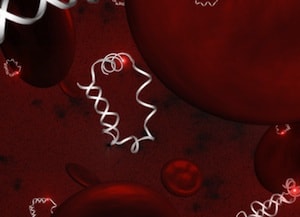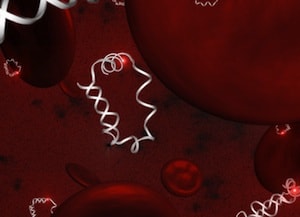
Over the past several years we have cited substantial progress in making ever more complex molecular machinery using structural DNA nanotechnology. Much of this work is focused on eventual medical applications, so it becomes important to ask how fragile such machinery would be in human serum and blood. A year ago we cited work work showing that a Lipid coat protects DNA nanorobot from immune attack, and six months ago that Swarms of DNA nanorobots execute complex tasks in living animals. More recently researchers at Boise State University have demonstrated that some DNA nanomachines are surprisingly stable in human serum and blood. From a Boise State news article “Nanobots! – DNA Nanomachines Operating In Blood” (scroll down):
Everyone knows DNA is rapidly degraded by enzymes in serum; except it isn’t–at least not always. While most studies of DNA in serum use fetal bovine serum, which exhibits a high enzyme activity and does degrade DNA rapidly, few studies have looked at DNA nanostructures in human serum. With the aim of creating new tools for biomedical diagnostic applications in humans (sorry bovines!), Sara Goltry, a PhD student in Materials Science & Engineering at Boise State, and co-workers measured the lifetimes of DNA devices in human serum and blood. The results of their four-year study, published recently in Nanoscale [abstract], show that some DNA nanostructures survive in human serum for about two days while others last only about an hour. Interestingly, the device lifetime can be programmed by changing the shape of the molecule. Beyond lifetime studies, Goltry also demonstrated that a circular DNA nanomachine operates in human serum and blood just fine. The nanomachine can be made to open and close with DNA fuels, similar to the DNA tweezers first published by Yurke et al. in 2000. Demonstrating operation in serum and blood supports the goal of building programmable molecular machines as a means to engineer new DNA-based tools for biotechnology.
After a no-cost registration, a full text PDF of the above research article can be downloaded at the above URL. A three-state DNA nanomachine (a tweezers that can be open, closed, or in the relaxed neutral position) and a two-state linear DNA probe were examined in buffer, in fetal bovine serum, in human serum, or in human whole blood. Samples were incubated for various times at room temperature or at body temperature of 37° C, and then assayed for either degradation of the ability of the structures to cycle through the various operational states. Overall, the structures lasted and were functional in human blood and serum about six times longer than in bovine serum, so that, for example, nanorobots intended for therapy could have several hours to a day or more to perform their intended functions. A number of factors that affect stability, including the shape of the device, were identified. As the field of structural DNA nanotechnology moves toward clinical trials, this research provides reason to test devices as closely as possible to conditions in human patients, because animal results may not always be good predictors, and it also provides clues as to factors that might be varied to improve performance.
—James Lewis, PhD

